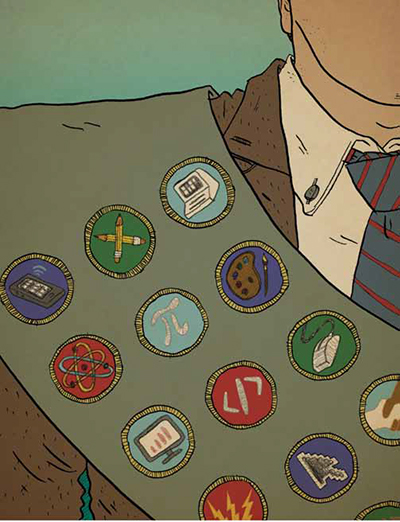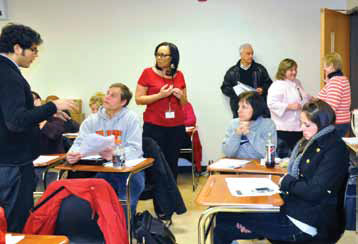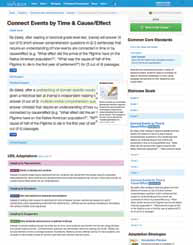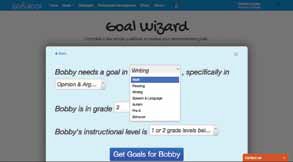There’s a Badge For That

Digital badges have captured the imagination of many educators, including those frustrated with current assessment techniques and practices. A more thorough explanation and history of digital badges is available through a report released last August by the Alliance for Excellent Education (http://all4ed.org/wpcontent/uploads/2013/09/DigitalBadges.pdf ) or through the Mozilla OpenBadges project (http://openbadges.org/). However, a simple definition for a digital badge is digital recognition for accomplishing a skill or acquiring knowledge after completing an activity (e.g., a course, module, or project). In the world of digital badges, there are those who create badges, those who attempt to achieve badges, those who recognize badges, and those who seek to know people who have obtained certain badges. Digital badges have arguably taken off in popularity given the increase in massive open courses that are often free and thus do not produce credits. In sum, digital badges have become an important way to demonstrate a shared understanding of accomplished outcomes.
Though they may have capital in multiple domains, digital badges are often new to teachers and those who offer professional development. However, there are at least three key areas where digital badges have implications for teachers and their continuing education.
1.–Digital Badges for Teacher Professional Development. Teachers and educators often preach the importance of personalization and individualization of content for students. However, professional development experiences for teachers are often one-size-fits-all excursions. By engaging teachers in conversations about digital badges, district professionals are empowering teachers to engage in conversations about what skills and knowledge they need and want. Additionally, when teachers earn badges, they become part of a community. They are recognized as members who have specific expertise, knowledge, and abilities. This is powerful as it recognizes teachers as professionals who can assess their current instructional needs and engage in learning that addresses those needs.
2.–Digital Badges for Teacher Education. District personnel and teachers need to be aware that a conversation is happening at the university level, led by educators like Ian O’Byrne and Greg McVerry (http://wiobyrne.com/ and http://jgregorymcverry.com/). This conversation is focused on how teacher certification at the university, state, and national levels might begin to incorporate assessment through digital badges. At this stage, it is too early to suggest implications for professional development. However, school district personnel and teachers could begin to work with teacher educators to shape badge content and requirements.
3.–Digital Badges for Instruction. Teachers are often introduced to badges in professional development as consumers of digital badges. However, teachers should begin considering how they could become producers of badges. One goal of this work is for teachers to consider how they could translate content and skills to badges as alternative forms of assessment for students.
It is worth noting that teachers and district personnel need not investigate badges because they are the latest fad. Rather, badges represent a movement for understanding how to use alternative assessment techniques. Experimenting with badges is not just for testing, but can also be used to improve instruction, motivate students, and better represent acquired knowledge, skills, and attitudes. How can district personnel introduce this topic into their educational discussions? How can a teacher learn more about digital badges for professional development and for future integration into the K-12 classroom? There are three recommendations.
1.–Develop a deeper understanding of digital badges. Teachers can begin by reading about badge implementation. For instance, this past summer, the city of Chicago launched a summer learning initiative with badges (http://www.macfound.org/programs/digital-badges/). Connected Learning TV also hosted webinars and twitter chats about digital badges (http://connectedlearning.tv). Engaging in these professional conversations and reviewing these case studies can help district personnel and teachers develop a conceptual understanding of badges while also beginning to envision local possibilities.
Tools and ideas to transform education. Sign up below.
2.–Earn a badge. OpenBadges (http://openbadges.org/) has made it incredibly easy to earn your first badge. A visitor to the site clicks on the word “earn,” takes a quiz, and earns a badge. From here, readers can explore an OpenBadges community to see others that are offering badges.
3.–Create a badge. It is important to remember that digital badges are a way to visually represent quality and valuable learning. You can begin your badge creation with the following series of questions:
* Have you explored existing badges? Is there someone who has already done the work you are trying to do so that you could simply adapt and become part of a community rather than reinventing the wheel?
* What are you assessing? Will your digital badges align with particular standards and competencies? If so, this should be specifically addressed so learners know their learning objectives. This could also help make the badge more meaningful to the learner.
* How will you earn the badge? What are the criteria, artifacts, or work samples that will be produced in order to earn the badge?
* What are the specific steps learners would take as they create their work? How long do you anticipate that it will take for someone to complete the badge?
* How will you assess the work? Will you design and implement rubrics?
* Will this be a series of badges? If so, how do the badges build upon one another? Is there a particular order in which the badges should be earned?
Once these questions are answered, educators can explore where they will host their badges.
There are numerous platforms that hosts badge systems, including OpenBadges (http://openbadges.org/), Achievery (http://achievery.com/), P2PU (https://p2pu.org/en/), and Credly (https://credly.com/). These communities can help district personnel and teachers create, develop, and manage digital badges, as well as create connections to other educators who might be pursing similar badges.
These same platforms and communities can also assist with the actual design of the badges, including the log, the title, and the badge tags. The design is crucial because it is the visual representation of specific knowledge and skills. Educators can utilize Web sites such as Image Bot (http://www.flamingtext.com/imagebot/editor) for the logo design or they can use their own image editing software. Once the design is complete and the badge is uploaded, the badges can be earned and awarded. They can also be included in learning or content management systems.
Combining professional development and digital badges could mean offering innovative content that leads to a badge as an achieved outcome. However, the focus and purpose of introducing the terms together is to reinforce the notion that those who conduct professional development also need to begin to consider the advantages of digital badges. In the end, it is pivotal for educators to grasp the potential of rewarding specificity of knowledge and skill acquisition through digital badges.
Richard E. Ferdig is the Summit Professor of Learning Technologies, RCET, at Kent State University.
Kristine E. Pytash is an assistant professor of literacy education at Kent State University.
Revamping PD and teacher evaluation in Michigan
Swartz Creek Community Schools use teacher evaluations to improve teaching and student outcomes.

Challenge: Swartz Creek (MI) Community Schools (SCCS ) understood the potential to improve teaching— and ultimately student outcomes—through effective teacher evaluations that informed professional learning. To ensure such improvement-focused evaluations, district officials knew they needed a process that demonstrated administrators’ proficiency in conducting teaching observations. Equally important, they needed an individualized process to connect evaluation results with ongoing professional learning for teachers.
Solution: To address this challenge, the district adopted the Teachscape Focus Observation Training and Assessment system and the Teachscape Reflect Observation and Evaluation Management system. With Teachscape Focus, administrators are trained to conduct accurate and consistent teaching observations based on Charlotte Danielson’s Framework for Teaching (FFT). Teachers are taught the framework based on which subjects are being evaluated. “Teachscape has helped us establish a common language around teaching practice using the FFT,” says Adam Hartley, assistant superintendent of curriculum and instruction at SCCS . “This common language, when used as an embedded part of the evaluation and professional learning processes, has been essential in creating a cycle of continuous improvement.”
Using Teachscape Reflect, administrators conduct and manage teacher evaluations and then work collaboratively with teachers on data-driven professional development based on the evaluations. Together, they discuss areas of strength and weakness and determine strategies for instructional improvement. In addition, teachers at SCCS participate in professional learning communities to reflect on their practices and learn from one another.
Teachscape has allowed district leaders to evaluate its teachers more effectively. By providing the necessary training and assessment, all administrators and teachers understand and use the same definitions and criteria for evaluating teaching, thus creating teacher engagement and inter-rater reliability across the district. And with an evaluation process that is entirely online, observations are more efficient and evaluations are more transparent. Looking ahead, the district plans to more heavily implement professional learning workshops focused on specific content areas.
Developing a long-term plan for Common Core implementation
Teachers in Syracuse receive additional training to help them deliver Common Core instruction.

Challenge: Three years ago, when New York State adopted Common Core State Standards for English Language Arts & Literacy and Mathematics, the Syracuse (NY) City School District (SCSD) needed to develop a strong, long-term platform for professional development around the Common Core implementation. The district saw the shift to Common Core State Standards as an opportunity with the potential to dramatically improve student achievement. They also knew that the success of educational change efforts hinged on a careful balance between supportive training and new practice demands.
District leaders envisioned an educator effectiveness system that would be based on a thoughtful, constructive use of tools, and they were determined to craft a reform plan that aligned support and evaluation systems to the demands of Common Core standards. They needed a road map to focus on key strategies and practices that would increase instructional rigor and the complexity of unit and lesson content.

Solution: In 2012, the district partnered with Insight Education Group to develop customized instructional frameworks that support the teaching required by Common Core standards. They created a plan for the district to obtain meaningful feedback from instructional leaders and teachers, build confidence in the validity of the tools, and develop PD that would support Common Core standards. SCSD formed a task force, and the Insight Education Group guided the task force in analyzing existing instructional effectiveness documents against what was being done across the country to construct the teaching and learning framework and the building leadership framework and rubric. They built additional frameworks to support the work of instructional coaches, library media specialists, and other positions across the district.
To ensure that teachers are evaluated equitably using the new frameworks and evaluation systems, Insight Education Group developed a certification process for principals, which was implemented prior to conducting high-stakes evaluations. Insight also facilitates monthly sessions for principals to watch video case studies and live co-observations. All teacher observers attend these sessions to increase their inter-rater reliability scores. School leaders also receive training on how to coach and develop both high- and low-performing teachers. Last, but not least, Insight Education Group provides PD for teachers to clarify and model the instructional practices described in the teaching and learning framework.
DC Public Schools improves PD in various ways
Challenge: As part of its district-wide priority to deliver high-quality professional development, the District of Columbia Public Schools (DCPS) wanted to help teachers increase the quality of students’ IEP goals. DCPS faced the challenge of rolling out an online IEP goal bank system-wide that could continuously train teachers on aligning IEP goals with Common Core standards. In addition, teachers who were hired after the school year started would not have had access to the robust trainings provided in August.



Solution: To work on their IEP goals, DCPS partnered with Goalbook to develop a train-the- trainer approach to rolling out PD designed to increase the quality and alignment to the Common Core standards for IEP goals for students with disabilities. The district has 10 trainers that can deliver ongoing PD using Goalbook’s online repository to write student goals. For teachers hired after the school year starts, an online portal provides a customized version of Better Lesson (betterlesson.com), an online library of documents, presentations, full lessons, complete units, and courses that support the adoption of the Common Core standards and goals of the DCPS academic plan. Through its social networking functionality, the site lets teachers grow professionally and make connections with fellow educators across the district and beyond. The portal also provides relevant, differentiated, high-quality PD, including mini-libraries of resources on how to teach effectively, video clips showing great teaching by DCPS teachers, and an extensive library of videos and articles that show effective teaching techniques.
